Effects of Graphene Nanoplates on the Mechanical Behavior and Strengthening Mechanism of 7075Al Alloy
Abstract
:1. Introduction
2. Experimental
3. Results and Discussion
3.1. Microstructures of the Composites
3.2. Mechanical Properties
3.3. Strengthening Mechanism
4. Conclusions
Author Contributions
Funding
Conflicts of Interest
References
- Starink, M.J.; Li, X.M. Effect of compositional variations on characteristics of coarse intermetallic particles in overaged 7000 aluminium alloys. Mater. Sci. Technol. 2001, 17, 1324–1328. [Google Scholar]
- Liu, X.-Y.; Wang, C.-C.; Wang, X.; Zhao, Z.-J.; Wu, M.; Huang, J.-C.; Huang, Z.-H. Microstructure Optimization and Comprehensive Property Improvement of Al-4.47Zn-2.13Mg-1.2Cu Alloy by Non-isothermal Aging Treatment. JOM 2019, 72, 1540–1551. [Google Scholar] [CrossRef]
- Jiang, Y.-Y.; Xu, R.; Tan, Z.-Q.; Ji, G.; Fan, G.-L.; Li, Z.; Xiong, D.-B.; Guo, Q.; Li, Z.-Q.; Zhang, D. Interface-induced strain hardening of graphene nanosheet/aluminum composites. Carbon 2019, 146, 17–27. [Google Scholar] [CrossRef]
- Guinea, F.; Castro Neto, A.H.; Peres, N.M.R. Electronic properties of stacks of graphene layers. Solid State Commun. 2007, 143, 116–122. [Google Scholar] [CrossRef]
- Chen, F.; Gupta, N.; Behera, R.K.; Rohatgi, P.K. Graphene-Reinforced Aluminum Matrix Composites: A Review of Synthesis Methods and Properties. JOM 2018, 70, 837–845. [Google Scholar] [CrossRef]
- Li, J.-C.; Zhang, X.-X.; Geng, L. Effect of heat treatment on interfacial bonding and strengthening efficiency of graphene in GNP/Al composites. Compos. Part A Appl. Sci. Manuf. 2019, 121, 487–498. [Google Scholar] [CrossRef]
- Jaim, H.M.I.; Isaacs, R.A.; Rashkeev, S.N.; Kuklja, M.; Cole, D.P.; LeMieux, M.C.; Jasiuk, I.; Nilufar, S.; Salamanca-Riba, L.G. Sp2 carbon embedded in Al-6061 and Al-7075 alloys in the form of crystalline graphene nanoribbons. Carbon 2016, 107, 56–66. [Google Scholar] [CrossRef] [Green Version]
- Iqbal, A.K.M.A.; Sakib, N.; Iqbal, A.K.M.P.; Nuruzzaman, D.M. Graphene-based nanocomposites and their fabrication, mechanical properties and applications. Materialia 2020, 12, 100815. [Google Scholar] [CrossRef]
- Bisht, A.; Srivastava, M.; Kumar, R.M.; Lahiri, I.; Lahiri, D. Strengthening mechanism in graphene nanoplatelets reinforced aluminum composite fabricated through spark plasma sintering. Mater. Sci. Eng. A 2017, 695, 20–28. [Google Scholar] [CrossRef]
- Zhang, H.-P.; Xu, C.; Xiao, W.-L.; Ameyama, K.; Ma, C.-L. Enhanced mechanical properties of Al5083 alloy with graphene nanoplates prepared by ball milling and hot extrusion. Mater. Sci. Eng. A 2016, 658, 8–15. [Google Scholar] [CrossRef]
- Wang, J.-Y.; Li, Z.-Q.; Fan, G.-L.; Pan, H.-H.; Chen, Z.-X.; Zhang, D. Reinforcement with graphene nanosheets in aluminum matrix composites. Scr. Mater. 2012, 66, 594–597. [Google Scholar] [CrossRef] [Green Version]
- Zhao, M.; Xiong, D.-B.; Tan, Z.-Q.; Fan, G.-L.; Guo, Q.; Guo, C.-P.; Li, Z.-Q.; Zhang, D. Lateral size effect of graphene on mechanical properties of aluminum matrix nanolaminated composites. Scr. Mater. 2017, 139, 44–48. [Google Scholar] [CrossRef]
- Gowrishankar, M.C.; Hiremath, P.; Shettar, M.; Sharma, S.; Rao, U.S. Experimental validity on the casting characteristics of stir cast aluminium composites. J. Mater. Res. Technol. 2020, 9, 3340–3347. [Google Scholar]
- Kumar, A.; Singh, R.C.; Chaudhary, R. Recent progress in production of metal matrix composites by stir casting process: An overview. Mater. Today Proc. 2020, 21, 1453–1457. [Google Scholar] [CrossRef]
- Rohatgi, P.K.; Ajay Kumar, P.; Chelliah, N.M.; Rajan, T.P.D. Solidification Processing of Cast Metal Matrix Composites Over the Last 50 Years and Opportunities for the Future. JOM 2020, 72, 2912–2926. [Google Scholar] [CrossRef]
- Park, J.K. Correlation between Microstructure and Calorimetric Behavior of Aluminum Alloy 7075 and AI-Zn-Mg Alloys in Various Tempers. Mater. Sci. Eng. A 1989, 114, 197–203. [Google Scholar] [CrossRef]
- Pan, Y.-L.; Zhang, D.; Liu, H.-R.; Zhuang, L.-Z.; Zhang, J.-S. Precipitation hardening and intergranular corrosion behavior of novel Al-Mg-Zn(-Cu) alloys. J. Alloys Compd. 2021, 853, 157199. [Google Scholar] [CrossRef]
- Zhao, J.-H.; Deng, Y.-L.; Tang, J.-G.; Zhang, J. Effect introduced high density of precipitates on the microstructural evolutions during multi-direction forging of Al–Zn–Mg–Cu alloy. Mater. Sci. Eng. A 2020, 798, 139927. [Google Scholar] [CrossRef]
- Ma, G.-N.; Wang, D.; Liu, Z.-Y.; Xiao, B.-L.; Ma, Z.-Y. An investigation on particle weakening in T6-treated SiC/Al–Zn–Mg–Cu composites. Mater. Charact. 2019, 158, 109966. [Google Scholar] [CrossRef]
- Dong, Y.-F.; Ren, B.-H.; Wang, K.; Wang, J.-R.; Leng, J.-F. Effects of graphene addition on the microstructure of 7075Al. Mater. Res. Express 2020, 7, 026510. [Google Scholar] [CrossRef]
- Ma, K.; Wen, H.; Hu, T.; Topping, T.D.; Isheim, D.; Seidman, D.N.; Lavernia, E.J.; Schoenung, J.M. Mechanical behavior and strengthening mechanisms in ultrafine grain precipitation-strengthened aluminum alloy. Acta Mater. 2014, 62, 141–155. [Google Scholar] [CrossRef]
- Williamson, G.K.; Smallman, R.E. III. Dislocation densities in some annealed and cold-worked metals from measurements on the X-ray debye-scherrer spectrum. Philos. Mag. 1956, 1, 34–46. [Google Scholar] [CrossRef]
- Williamson, G.K.; Hall, W.H. X-ray line broadening from filed aluminium and wolfram. Acta Metall. 1953, 1, 22–31. [Google Scholar] [CrossRef]
- Kril, C.E.; Birringer, R. Estimating grain-size distributions in nanocrystalline materials from X-ray diffraction profile analysis. Philos. Mag. A 1998, 77, 621–640. [Google Scholar] [CrossRef]
- Liu, M.-P.; Jiang, T.-H.; Wang, J.; Liu, Q.; Wu, Z.-J.; Yu, Y.-D.; Skaret, P.C.; Roven, H.J. Aging behavior and mechanical properties of 6013 aluminum alloy processed by severe plastic deformation. Trans. Nonferr. Met. Soc. China 2014, 24, 3858–3865. [Google Scholar] [CrossRef]
- Schiller, I.; Gubicza, J.; Kovács, Z.; Chinh, N.Q.; Illy, J. Precipitation and Mechanical Properties of Supersaturated Al-Zn-Mg Alloys Processed by Severe Plastic Deformation. Mater. Sci. Forum 2006, 519–521, 835–840. [Google Scholar] [CrossRef] [Green Version]
- Azarniya, A.; Taheri, A.K.; Taheri, K.K. Recent advances in ageing of 7xxx series aluminum alloys: A physical metallurgy perspective. J. Alloys Compd. 2019, 781, 945–983. [Google Scholar] [CrossRef]
- Lu, T.-W.; Chen, W.-P.; Wang, P.; Mao, M.-D.; Liu, Y.-X.; Fu, Z.-Q. Enhanced mechanical properties and thermo-physical properties of 7075Al hybrid composites reinforced by the mixture of Cr particles and SiCp. J. Alloys Compd. 2018, 735, 1137–1144. [Google Scholar] [CrossRef]
- Song, J.-Y.; Guo, Q.; Ouyang, Q.-B.; Su, Y.-S.; Zhang, J.; Lavernia, E.J.; Schoenung, J.M.; Zhang, D. Influence of interfaces on the mechanical behavior of SiC particulate-reinforced Al–Zn–Mg–Cu composites. Mater. Sci. Eng. A 2015, 644, 79–84. [Google Scholar] [CrossRef]
- Xiu, Z.-Y.; Yang, W.-S.; Dong, R.-H.; Hussain, M.; Jiang, L.-T.; Liu, Y.-X.; Wu, G.-H. Microstructure and Mechanical Properties of 45 vol.% SiCp/7075Al Composite. J. Mater. Sci. Technol. 2015, 31, 930–934. [Google Scholar] [CrossRef]
- Lu, T.-W.; Chen, W.-P.; Xu, W.-Y.; Wang, P.; Mao, M.-D.; Liu, Y.-X.; Fu, Z.-Q. The effects of Cr particles addition on the aging behavior and mechanical properties of SiCp/7075Al composites. Mater. Charact. 2018, 136, 264–271. [Google Scholar] [CrossRef]
- Lu, T.-W.; Scudino, S.; Chen, W.-P.; Wang, P.; Li, D.-Y.; Mao, M.-D.; Kang, L.-M.; Liu, Y.-X.; Fu, Z.-Q. The influence of nanocrystalline CoNiFeAl0.4Ti0.6Cr0.5 high-entropy alloy particles addition on microstructure and mechanical properties of SiCp/7075Al composites. Mater. Sci. Eng. A 2018, 726, 126–136. [Google Scholar] [CrossRef]
- Li, X.-W.; Cai, Q.-Z.; Zhao, B.-Y.; Liu, B.; Li, W.-W. Precipitation behaviors and properties of solution-aging Al-Zn-Mg-Cu alloy refined with TiN nanoparticles. J. Alloys Compd. 2018, 746, 462–470. [Google Scholar] [CrossRef]
- Cheng, J.-F.; Li, G.-R.; Wang, H.-M.; Li, P.-S.; Li, C.-Q. Influence of High Pulsed Magnetic Field on the Dislocations and Mechanical Properties of Al2O3/Al Composites. J. Mater. Eng. Perform. 2018, 27, 1083–1092. [Google Scholar] [CrossRef]
- Sun, Y.-P.; Yan, H.-G.; Su, B.; Jin, L.; He, J.-M. Microstructure and Mechanical Properties of Spray Deposition Al/SiCp Composite After Hot Extrusion. J. Mater. Eng. Perform. 2011, 20, 1697–1702. [Google Scholar] [CrossRef]
- Ebrahimi, S.H.S.; Dehghani, K.; Aghazadeh, J.; Ghasemian, M.B.; Zangeneh, S. Investigation on microstructure and mechanical properties of Al/Al-Zn-Mg–Cu laminated composite fabricated by accumulative roll bonding (ARB) process. Mater. Sci. Eng. A 2018, 718, 311–320. [Google Scholar] [CrossRef]
- Schmidtke, K.; Palm, F.; Hawkins, A.; Emmelmann, C. Process and Mechanical Properties: Applicability of a Scandium modified Al-alloy for Laser Additive Manufacturing. Phys. Procedia 2011, 12, 369–374. [Google Scholar] [CrossRef] [Green Version]
- Ferguson, J.B.; Schultz, B.F.; Venugopalan, D.; Lopez, H.F.; Rohatgi, P.K.; Cho, K.; Kim, C.-S. On the superposition of strengthening mechanisms in dispersion strengthened alloys and metal-matrix nanocomposites: Considerations of stress and energy. Met. Mater. Int. 2014, 20, 375–388. [Google Scholar] [CrossRef]
- Dai, L.-H.; Ling, Z.; Bai, Y.-L. Size-dependent inelastic behavior of particle-reinforced metal–matrix composites. Compos. Sci. Technol. 2001, 61, 1057–1063. [Google Scholar] [CrossRef]
- Zhang, Z.; Chen, D.-L. Consideration of Orowan strengthening effect in particulate-reinforced metal matrix nanocomposites: A model for predicting their yield strength. Scr. Mater. 2006, 54, 1321–1326. [Google Scholar] [CrossRef]
- Ferguson, J.B.; Thao, X.; Rohatgi, P.K.; Cho, K.; Kim, C.-S. Computational and analytical prediction of the elastic modulus and yield stress in particulate-reinforced metal matrix composites. Scr. Mater. 2014, 83, 45–48. [Google Scholar] [CrossRef]
- Wen, H.-M.; Topping, T.D.; Isheim, D.; Seidman, D.N.; Lavernia, E.J. Strengthening mechanisms in a high-strength bulk nanostructured Cu–Zn–Al alloy processed via cryomilling and spark plasma sintering. Acta Mater. 2013, 61, 2769–2782. [Google Scholar] [CrossRef]
- Seidman, D.N.; Marquis, E.A.; Dunand, D.C. Precipitation strengthening at ambient and elevated temperatures of heat-treatable Al(Sc) alloys. Acta Mater. 2002, 50, 4021–4035. [Google Scholar] [CrossRef]
- Fleischer, R.L. Solution hardening by tetragonal dist ortions: Application to irradiation hardening in F.C.C. crystals. Acta Metall. 1962, 10, 835–842. [Google Scholar] [CrossRef]
- Maung, K.; Earthman, J.C.; Mohamed, F.A. Inverse Hall–Petch behavior in diamantane stabilized bulk nanocrystalline aluminum. Acta Mater. 2012, 60, 5850–5857. [Google Scholar] [CrossRef]
- Gubicza, J.; Chinh, N.Q.; Krállics, G.; Schiller, I.; Ungár, T. Microstructure of ultrafine-grained fcc metals produced by severe plastic deformation. Curr. Appl. Phys. 2006, 6, 194–199. [Google Scholar] [CrossRef]
- Jiang, Y.-Y.; Tan, Z.-Q.; Fan, G.-L.; Wang, L.; Xiong, D.-B.; Guo, Q.; Su, Y.-S.; Li, Z.-Q.; Zhang, D. Reaction-free interface promoting strength-ductility balance in graphene nanosheet/Al composites. Carbon 2020, 158, 449–455. [Google Scholar] [CrossRef]
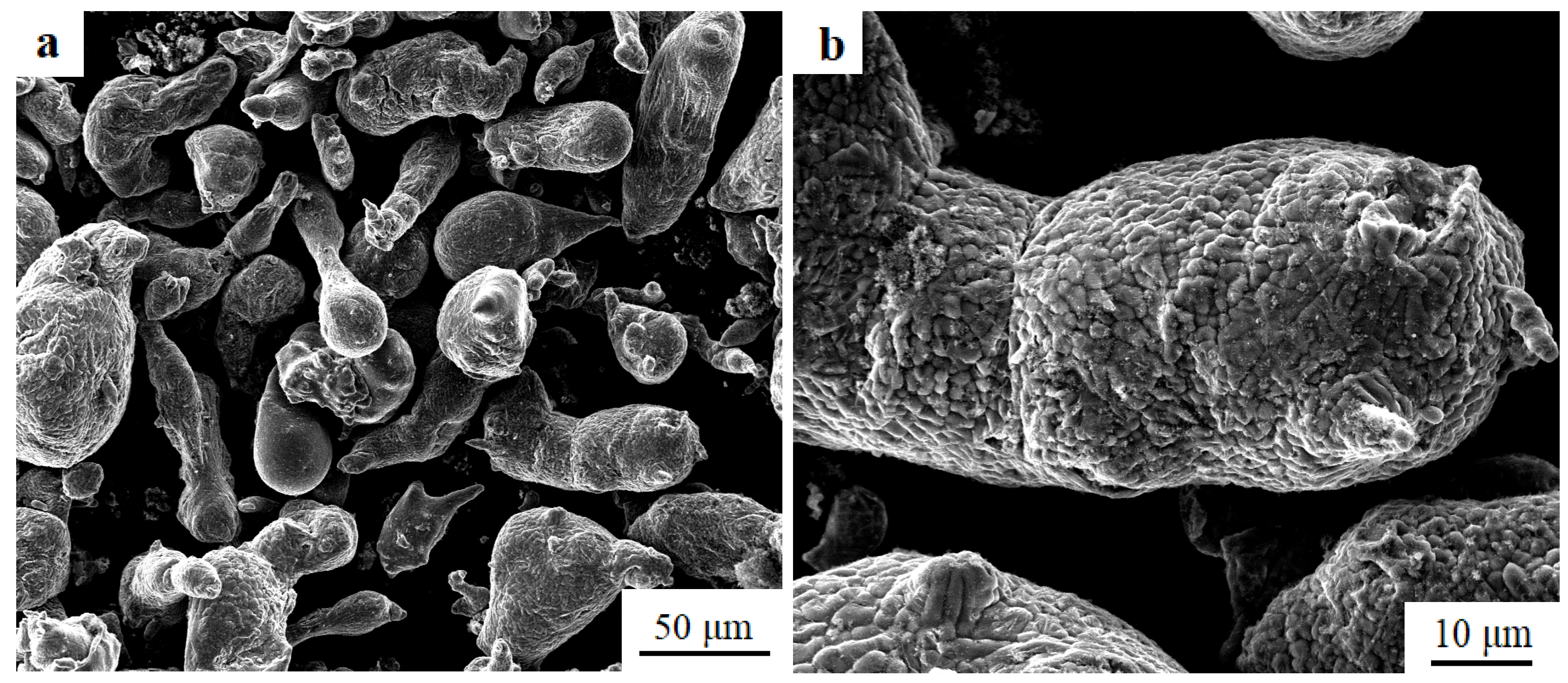
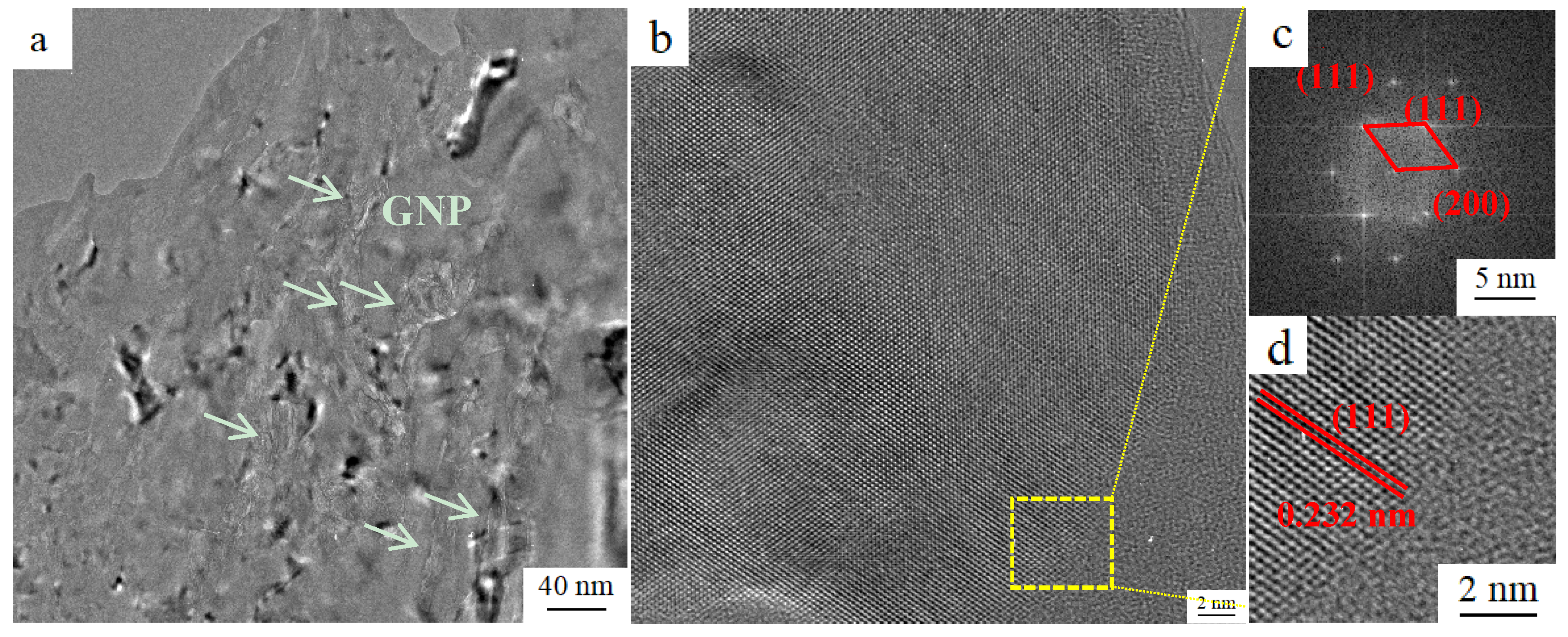
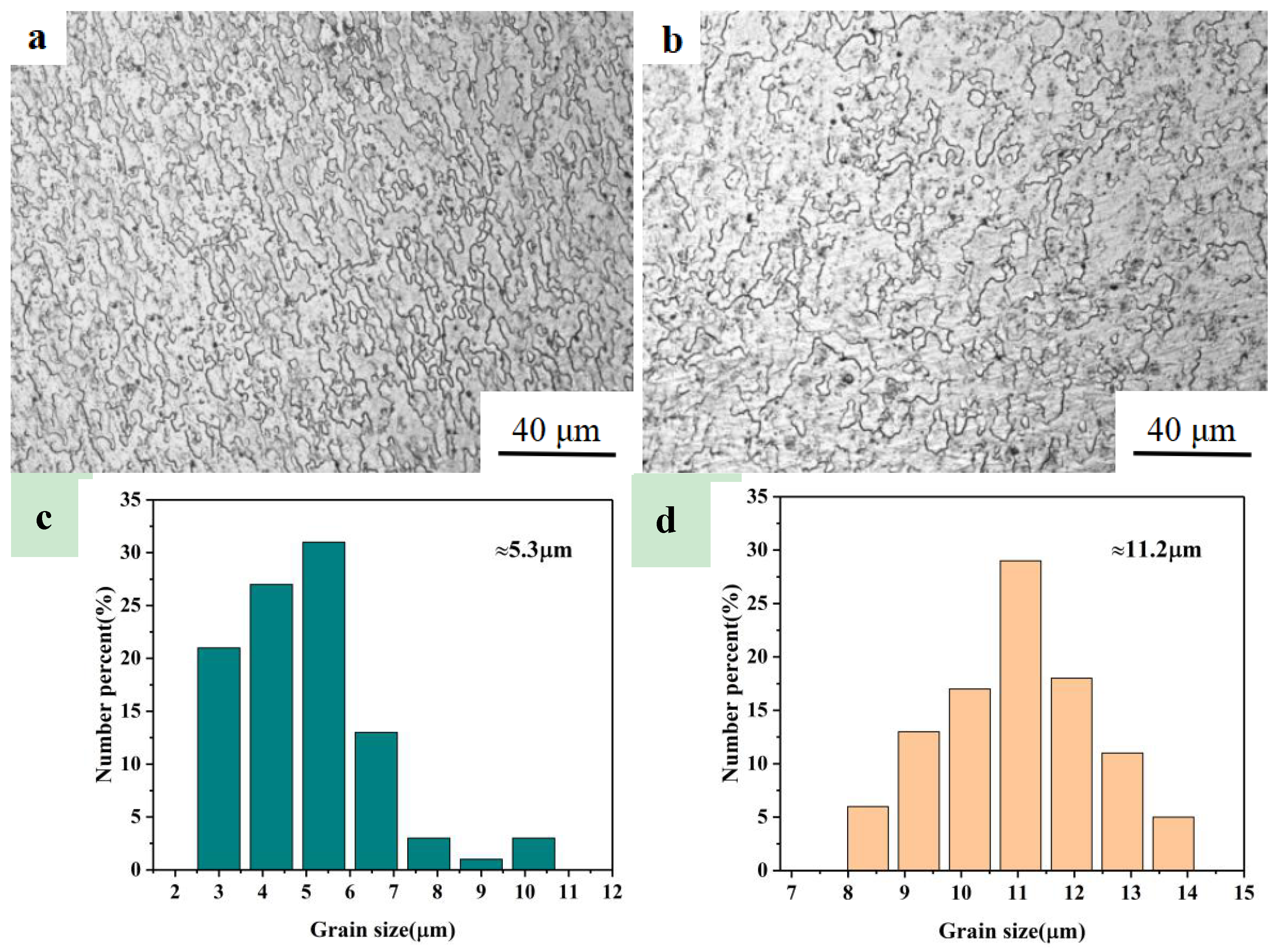

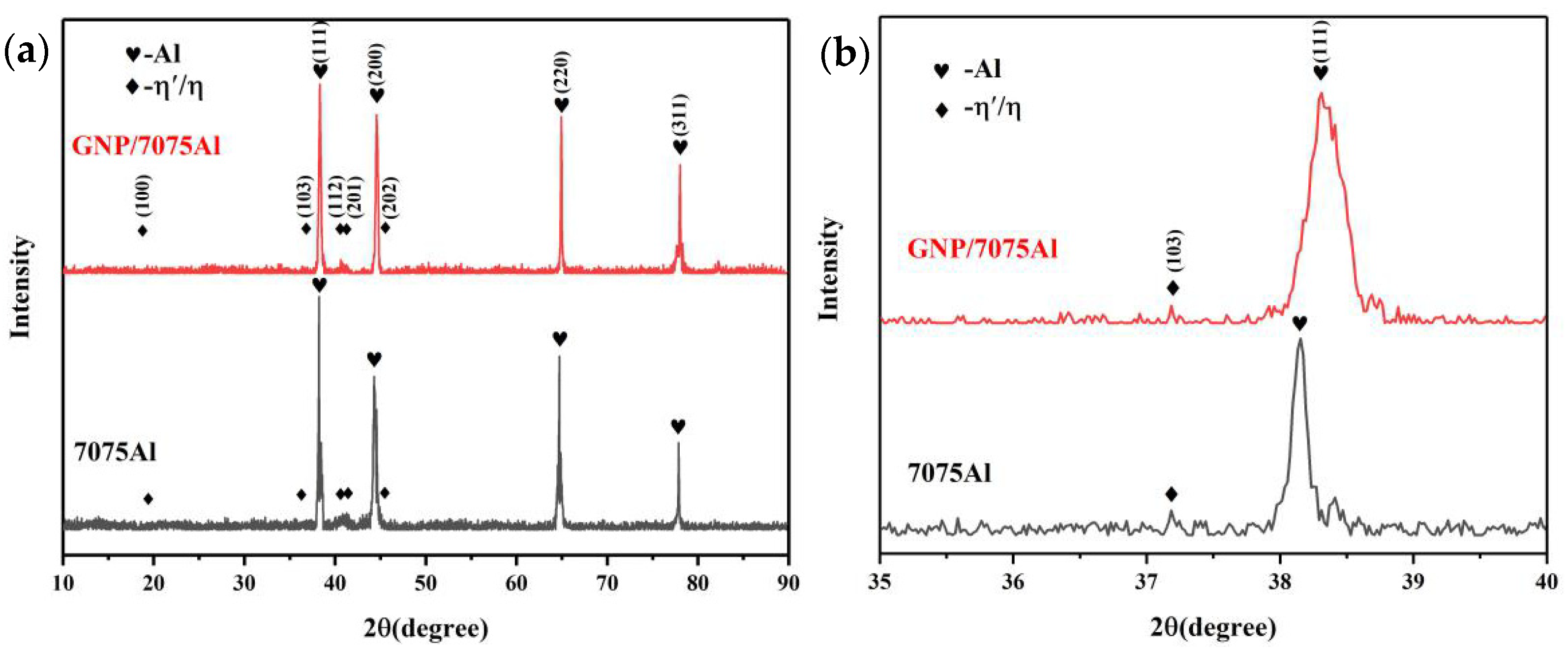
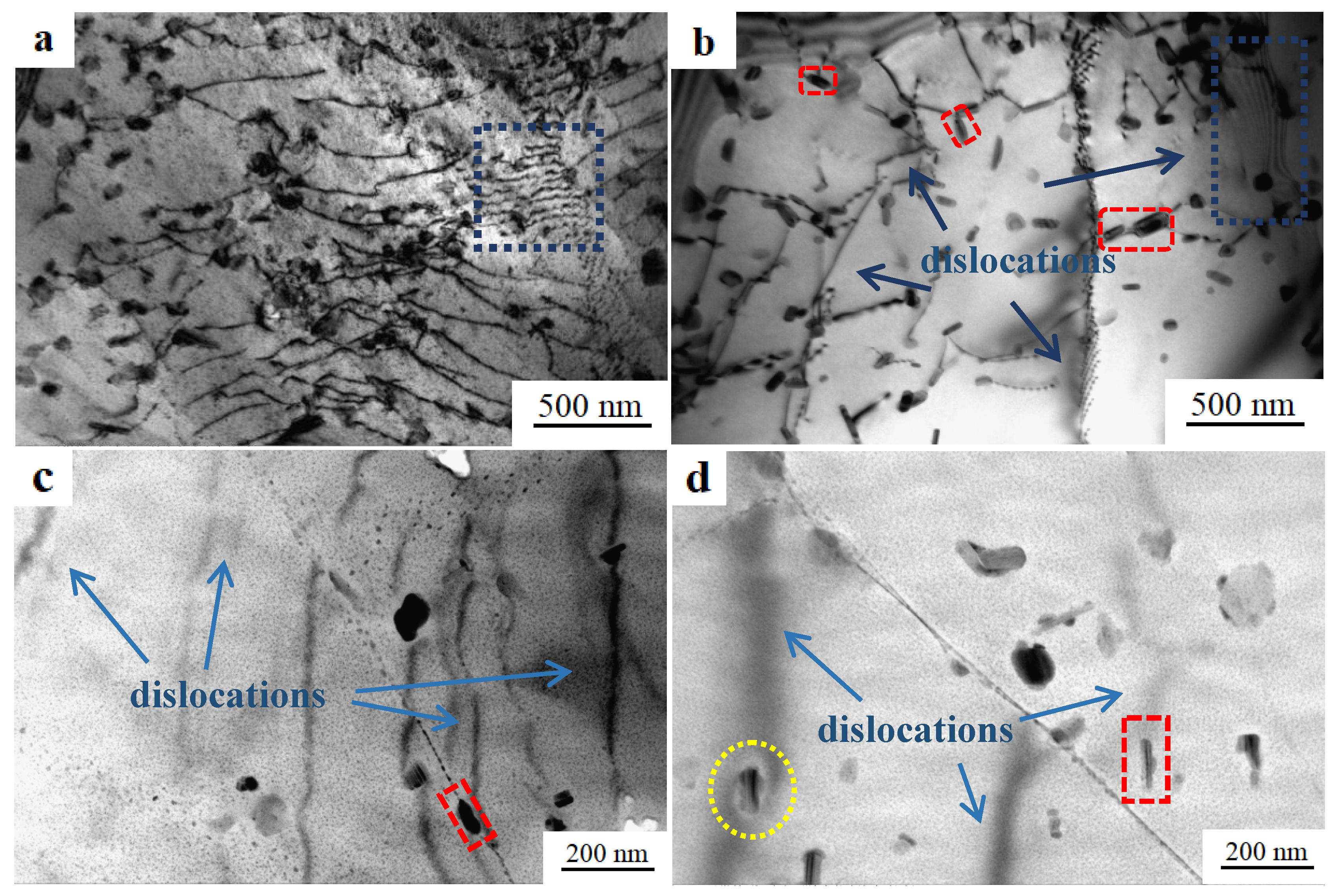

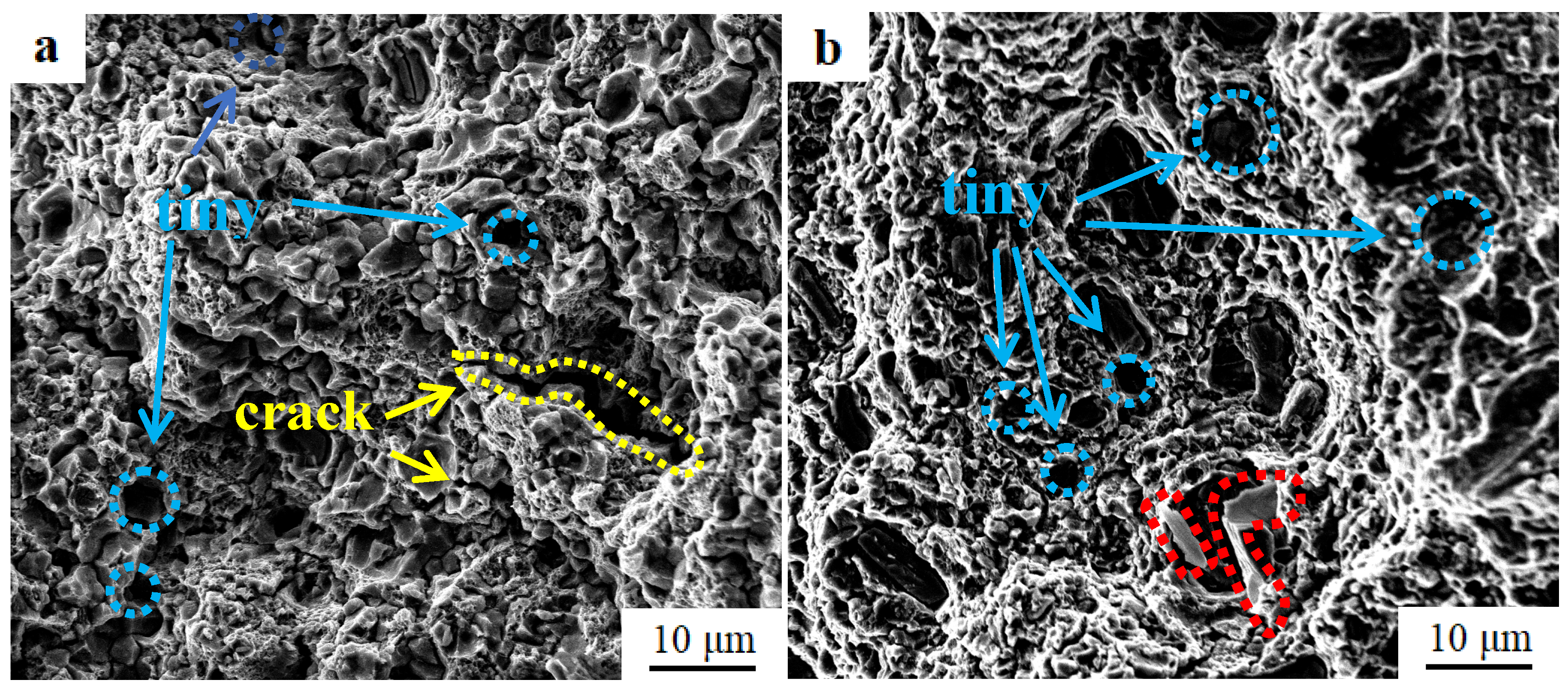
| Composites | Zn | Mg | Cu | Cr | Ti | Fe | Si | GNP | Al |
|---|---|---|---|---|---|---|---|---|---|
| GNP/7075Al | 5.6 | 2.5 | 1.6 | 0.2 | 0.2 | <0.1 | <0.1 | 0.2 | Bal |
| 7075Al | 5.6 | 2.5 | 1.6 | 0.2 | 0.2 | <0.1 | <0.1 | 0 | Bal |
| Symbol | Meaning | Values |
|---|---|---|
| M | Mean orientation factor | 3.06 for the fcc (Face Center Cubic) |
| b | Magnitude of the Burgers vector | 0.286 nm for fcc Al |
| G | Shear modulus | 26.9 GPa for Al 7075 |
| α | Constant | 0.2 for fcc metals |
| λp | mean edge-to-edge interprecipitate spacing (GNP/7075Al and 7075Al) | 20.5 nm; 22.7 nm |
| ky | Hall-Petch coefficient | 0.12 MPa/m1/2 |
| υ | Poisson ratio | 0.33 for Al 7075 |
| d | mean grain sizes (GNP/7075Al and 7075Al) | 5.3 μm; 11.2 μm |
| l | Mean length of η′ (GNP/7075Al and 7075Al) | 4.9 nm; 5.2 nm |
| ρ | dislocation density (GNP/7075Al and 7075Al) | 1.1 × 1015 m−2; 4.1 × 1014 m−2 |
| σ(Solid Solution) | σ(Grain Boundary) | σ(Precipitation) | σ(Dislocation) | σ(Load Transfer) | |
|---|---|---|---|---|---|
| GNP/7075Al | <<84 MPa | 52 MPa | 388 MPa | 156 MPa | 11.9 MPa |
| 7075Al | <84 MPa | 36 MPa | 361 MPa | 95 MPa | - |
Publisher’s Note: MDPI stays neutral with regard to jurisdictional claims in published maps and institutional affiliations. |
© 2020 by the authors. Licensee MDPI, Basel, Switzerland. This article is an open access article distributed under the terms and conditions of the Creative Commons Attribution (CC BY) license (http://creativecommons.org/licenses/by/4.0/).
Share and Cite
Leng, J.; Dong, Y.; Ren, B.; Wang, R.; Teng, X. Effects of Graphene Nanoplates on the Mechanical Behavior and Strengthening Mechanism of 7075Al Alloy. Materials 2020, 13, 5808. https://doi.org/10.3390/ma13245808
Leng J, Dong Y, Ren B, Wang R, Teng X. Effects of Graphene Nanoplates on the Mechanical Behavior and Strengthening Mechanism of 7075Al Alloy. Materials. 2020; 13(24):5808. https://doi.org/10.3390/ma13245808
Chicago/Turabian StyleLeng, Jinfeng, Yunfan Dong, Binghui Ren, Ran Wang, and Xinying Teng. 2020. "Effects of Graphene Nanoplates on the Mechanical Behavior and Strengthening Mechanism of 7075Al Alloy" Materials 13, no. 24: 5808. https://doi.org/10.3390/ma13245808




